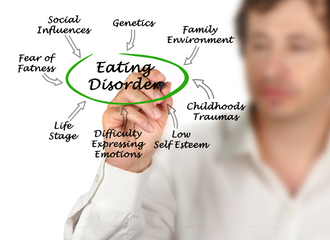Written By: Tiffany Smith, M.Ed, LMHC (she/her)
Professional Relations Representative, The Renfrew Center of Florida

8 Factors to Consider When Choosing a Residential Facility
Eating disorders are complex mental health conditions that require comprehensive treatment. For some, residential treatment may be the best option to provide the intensive care, structure and support needed for recovery. If you’re considering residential treatment facilities, here are the most important data points to compare.
1. Specialization in Eating Disorders
Most importantly, consider choosing a facility that specifically specializes in treating eating disorders. This may seem obvious, but there are many facilities that can treat eating disorders, but don’t solely specialize in it. The treatment team should include professionals with expertise in eating disorder treatment, such as therapists, dietitians, psychiatrists, and medical staff. Eating disorders are often multifaceted, involving not just food and weight but also psychological, emotional, and social factors. Specialized facilities are better equipped to address these complexities and provide holistic care. Recovering in a space where everyone is informed in eating disorders can create a supportive and understanding environment. This can be crucial for recovery, as it reduces feelings of isolation and shame that eating disorders often create. Receiving treatment at a facility that specializes in eating disorders can increase the likelihood of successful recovery and long-term health.
2. Comprehensive Assessment & Individualized Treatment Plans
A reputable treatment facility will conduct a thorough assessment to understand the unique needs of each client. A comprehensive eating disorder treatment assessment can also reveal if the treatment program and the client are a good fit for each other. Treatment plans should be tailored to address your specific needs, including any co-occurring mental health disorders or medical conditions. It’s important that prior to admission, you feel comfortable that the treatment facility can address any unique needs you may have and make accommodations as needed. Be sure to ask questions at the time of the assessment; this time is meant for the assessment team to get to know you and make recommendations, but it’s also meant for you to gather more information and feel more comfortable throughout the process.
3. Evidence-Based Treatment Approaches
Look for a facility that uses evidence-based practices, establishes markers of client progress, and has published peer-reviewed treatment outcomes to back up these practices. As eating disorders rarely travel alone, it’s also important to look for a program that utilizes a trans-diagnostic approach, meaning the treatment can address co-occurring issues or multiple diagnoses, rather than just the eating disorder symptoms. Creative Arts Therapy, such as art therapy, psychodrama, and movement therapy can also be supportive and helpful interventions in a residential treatment program. For those who may have difficulty expressing themselves through words —whether it’s difficulty verbalizing emotions or fear around sharing your story – the process of creating art, moving the body, and enacting scenes from the past can make it possible to gain insights and express feelings in a different way.
4. Nutritional Counseling & Meal Support
Ensure that the facility has a team of qualified registered dietitians who can provide nutritional counseling, meal planning, and mealtime support. Structured meal support should be available to help clients develop a healthy relationship with food and provide support and skills in the moment to help cope with difficult emotions, as well as eating disorder urges and behaviors that arise during meals. Meals and snacks on a predictable schedule also aid in healing and re-establishing the body’s built-in hunger and fullness cues. It’s important to work with dietitians and nutrition staff who have the experience and training to work with eating disorders, as they understand the nuances and appropriate supportive language when working with individuals in recovery.
5. Medical Monitoring & Support
Eating disorders can have serious medical complications. The facility should have medical staff available to monitor clients’ physical health and provide necessary education and medical interventions, if needed. If you or your loved one has a medical condition in addition to the eating disorder diagnosis, such as diabetes, it’s crucial the facility is equipped to support and monitor these conditions as well. While some residential programs have medical staff, not all have medical providers on site 24/7. Depending on the severity of the eating disorder symptoms and other co-occurring medical conditions, it may be necessary to choose a facility that includes the ongoing support and monitoring of a medical team.
6. Continuum of Care & Aftercare Planning
Choose a facility that offers a continuum of care, including step-down programs and aftercare planning. Ideally, patients gradually move through the lower levels of care after completing a residential program. These levels of care may include partial hospitalization programs (PHP), intensive outpatient programs (IOP), and outpatient treatment teams (OP). This step-down process ensures that clients receive the necessary structure and support as they adjust to their daily lives and follow their relapse prevention plans. Recovery from an eating disorder is often an ongoing, non-linear process that involves multiple stages. Transitioning to a lower level of care allows individuals to progressively build the skills and coping mechanisms needed for long-term recovery with the support of a treatment team and a community of peers.
7. Family Involvement
Family support is crucial in eating disorder recovery. Be sure to look for a program that involves family members (this can be the client’s chosen family or the client’s support system) in the treatment process by providing psychoeducation to family members, offering family therapy sessions, and/or providing support groups for your friends and family. Therapeutic services like these can improve understanding, compassion, and empathy family members have for their loved ones and can potentially increase their support and involvement throughout the entire recovery process. Support persons involvement is particularly important during residential treatment, as these are often the same individuals the client may be living with, eating meals with, and turning to for support when they’re back home.
8. Holistic Approach
Consider choosing a residential program that offers a holistic approach to treatment, addressing not just the symptoms of the eating disorder, but also the underlying emotional and psychological aspects. Eating disorders are not just about food and the body; they are often strategies an individual has learned to cope with difficult emotions or situations. In addition to individual therapy, nutritional support, medical treatment, psychiatry appointments and group therapy, specialized programming is also important, such as trauma-specific groups and substance use groups, to address underlying issues driving the eating disorder.
Conclusion
Recovery can be difficult, but it is much less difficult when you have the structure and the support you need and deserve. Eating disorders thrive in isolation and are maintained by shame, secrecy, and fear. The right residential treatment program can target these issues and create an environment where an eating disorder cannot easily thrive or survive. Choosing an eating disorder treatment facility is an important decision that calls for careful consideration. Hopefully by focusing on these 8 key factors, you can ensure that you find a facility that meets your unique psychological and medical needs and offers you a supportive and healing environment to recover.



